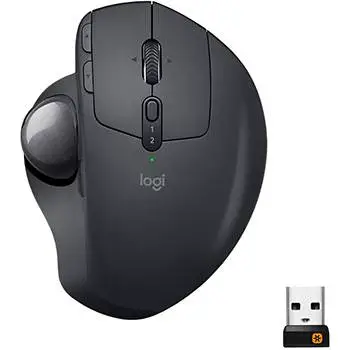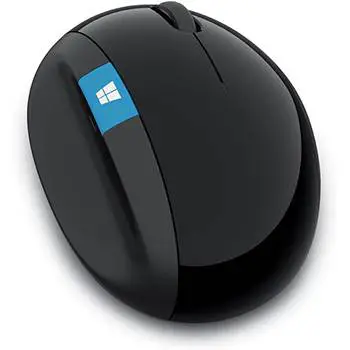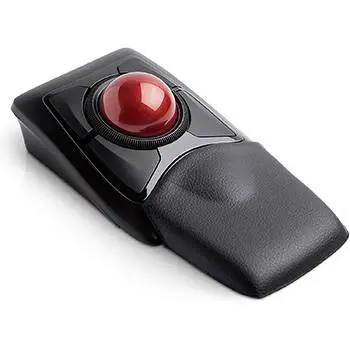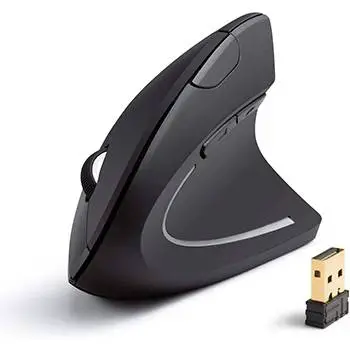We know which ergonomic mice are the best in the world. So, what’s the best ergonomic mouse? Keep reading our comprehensive ergonomic mouse guide to find out!
Like our advice for the best ergonomic keyboard, you are going to need to try a few and find what works best for your work style, desk setup, hand size, computer platform, type of work, and a million other factors.
However, we can still recommend the best product that will work well for most people.
You can use the following table as a super-quick guide to get in and grab a recommendation without much time.
You can’t go wrong with these options. If you have time, below this table is our summary of all types of ergonomic mice, and we recommend skimming the rest of the page to see if something catches your attention and should be on your consideration list to find your ideal ergonomic mouse.
Quick Look At Our Top 5 Picks For Best Ergonomic Mice:
- Logitech MX Master 3 Advanced Wireless Mouse (Best Overall)
- Logitech ERGO Wireless Trackball Mouse
- Microsoft Sculpt Ergonomic Mouse
- Kensington Expert Wireless Trackball Mouse
- Anker 2.4G Wireless Optical Vertical Mouse
Best Overall
| ||
| ||
| ||
| ||
|
The Best Guide To Ergonomic Mice
Want to dig in a little deeper? Below is our great guide to all kinds of mouse options. We suggest reading through and seeing what jumps out. If you can bug a colleague who has one or visit a retailer that carries one, you may be one of the lucky few who can try before you buy.
That probably won’t be true for you, though, so we recommend you check the return policy of the retailer of your choice to make sure you can switch it out or get a refund if the fit is not right.
What Makes A Mouse Ergonomic?
If there were a device to measure the objective ergonomic benefit of a particular computer peripheral, then choosing the right one for you would be easy. Unfortunately, there isn’t a specific metric that lets you know which is the most and best ergonomic product in a category and how they crowned it.
You could simply look for the product with the highest “ergonomic index” available, buy that, and ignore everything else. But of course, this won’t work, because there is no objective standard of “ergonomic-ness,” any more than there is an objective standard of comfort for shoes (or an actual English word “ergonomic-ness,” for that matter).
Different things work for different people, and that principle is not going to change anytime soon.
Your job is not to figure out what works for most people; it’s to figure out what works for you. But in doing that, it’s also helpful to have a basic understanding of the most common factors affecting user comfort. Here are a few of the most important factors to keep in mind that will likely influence how comfortable a particular mouse is for you.
Wrist Movement
Many ergonomic mice are designed with the idea of reducing wrist movement as much as possible.
The reasoning behind this, while not shared by everyone, is simple: bending your wrist a lot over time is what tends to deform the channels through which nerves run, so if you can stop bending your wrist or at least minimize how much you bend it, you are less likely to impinge a nerve.
It’s the same reason that people wear braces for carpal tunnel syndrome. (Not that braces are necessarily a good solution, but now we’re getting into medical territory.)
While I don’t know of an ergonomic mouse that comes with a brace to keep your wrist straight, many are designed to create a sort of “invisible brace.”
If a mouse is made large enough and is shaped correctly, it becomes easier to control by moving your arm than by bending your wrist.

The Airobic is an example of a large mouse designed to be moved with your whole arm.
Precision
When the main focus of an ergonomic mouse is on reducing wrist movement, one thing typically goes overboard: precision.
While your arm is big and powerful, it is not made for doing precise tasks. For example, imagine trying to write with your arm in a cast from fingers to elbow.
You could probably do it, but only in very big letters. It’s the same with mouse control.
You can accomplish quite a bit using the large muscles of your arms, but you may struggle with precise tasks like pixel-perfect work in Photoshop.
If your work involves many such tasks, you may prefer an ergonomic mouse design that reduces wrist movement the other way – by transferring the load to your fingers.
Pronation
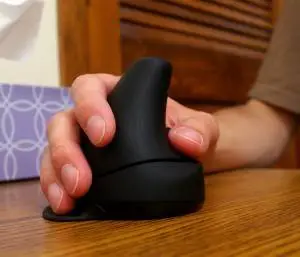
Most ergonomic mice make an effort to get your palm out of the horizontal plane. Some go entirely vertical; others, like the Rockstick shown here, choose a compromise angle.
Most ergonomic mice make an effort to get your palm out of the horizontal plane. Some go entirely vertical, while others choose a slightly different angle.
To understand pronation, sit down in front of a desk or table about elbow height, and lay your hands comfortably on the table in front of you.
Now, look at your hands. If they are flat, with palms straight out on the table, then you are either a very unusually shaped person or else you didn’t relax.
Because of the way the human body is built, it requires effort to flatten your palm in a downward position.
This effort isn’t very large, but the strain can build up significantly over time if you use a mouse that puts your palm straight down.
At the other end of the spectrum from pronation is the vertical mouse position.
While putting your hand at 90 degrees gets it as far as possible from total pronation, it must be noted that a straight vertical is not the most natural and comfortable position for most people either.
Rather, the hands of most users will land somewhere between zero and 90 degrees when relaxed.
Different ergonomic mouse manufacturers choose different angles to proclaim the “most natural.” If you can’t decide which is right, you’ll be glad to know that at least one (Oyster) makes the angle adjustable.
Okay, enough theory. Let’s look at some products and talk about how you can find the best ergonomic computer mouse.
How To Choose The Best Ergonomic Mouse
How can you find the right product? Well, you can follow this comprehensive guide, and you’ll find it much easier to pick the ideal mouse for your needs and wishes.
Types Of Ergonomic Mice
First of all, not all of these mice are the same. There are a few common categories you should be familiar with before you go over the reviews of individual products. Aside from the standard look, you’ll also often see vertical, trackball, ergonomic pen, and joystick mice. Here’s what you need to know about each type and how they differ.
Standard/Horizontal
A standard or a horizontal mouse looks very much like all other mice, with the main difference being that it’s shaped ergonomically. It’s the most popular type of ergonomic mouse on the market and offers more support for your hands and fingers than a mouse that’s not shaped ergonomically.
The key secret behind the designs of ergonomic horizontal mice is they usually weigh more and feel much more comfortable to the fingers. They also usually feature certain grooves and bumps that make the tactile experience even better.
If you’ve been using standard mice for a long time, the transition to horizontal ergonomic mice will be smooth and simple.
Vertical
A vertical mouse offers a completely different experience than a regular one. As the name suggests, the design requires you to place your hand vertically on the device in a position that’s close to your natural posture.
The vertical mouse appears as if it’s been turned 90 degrees, and it stimulates you to place your hand in a vertical position. The buttons are located on the mouse’s sides, letting you rest your wrist, since you won’t need to twist it as often. This is an excellent design that prevents the appearance of carpal tunnel syndrome and is also helpful for people already struggling with it.
One of the downsides of using a vertical ergonomic mouse is you’ll need some time to get used to using it. These designs tend to be more expensive than standard mice, but that’s not always the case.
Thanks to the natural position of your arm, a vertical mouse will encourage you to move your forearm rather than your wrist so your hands will feel more comfortable and rested.
Trackball
A trackball mouse has a trackball that you need to use to move the cursor. In most cases, the mouse base stays put, and you control the cursor by moving the trackball rather than moving the entire mouse around.
There are various trackball mouse designs, and all of them reduce the movement of your wrist to a minimum. The precision is great; however, it can slow you down in the beginning until you get more used to using it.
Another notable downside of using this type of mouse is it can take a while to get used to. Another thing users often mention is some people find it takes them longer to finish certain tasks when using a trackball mouse. That won’t be the case for everyone, though, so if you find the trackball design interesting and want to minimize your hand and wrist movement, you should give it a try.
Pen
A pen mouse is very straightforward, as it is exactly what you’d picture it to be. Pen mice are designed to be held as a pen or pencil, in turn minimizing your wrist movements. People with wrist pain and conditions will find the pen mouse helpful, but it can be tricky at first to move from a standard design to a pen design.
Joystick
Chances are, you’ve already seen a joystick for other devices before. Well, that’s exactly how this ergonomic mouse looks, and it’s a great alternative for people with CTS and other musculoskeletal problems. You’ll need to hold the mouse’s joystick with your hand in a vertical position to move the cursor on your screen.
Unfortunately, this mouse design also requires some getting used to, and for many users, it isn’t as precise as the other options we mentioned above. Still, despite this being a more niche option, many users swear by it and love its unique design.
Other Comfort Factors To Keep In Mind
What are the other things that a comfortable, well-designed mouse should have so you can crown it as the most ergonomic mouse or the best in its category? As we touched on briefly earlier, there isn’t a single best ergonomic mouse for everyone, because people prefer different features and designs.
Here are a few other features to keep in mind when choosing the right ergonomic mouse for you.
- Wired or wireless
- Your hand size compared to mouse size
- Ergonomic buttons (placement, customizable or not)
- DPI (dots per linear inch, or how many pixels the cursor moves on your screen for every physical inch you move the mouse)
Ergonomic Mouse vs Regular Mouse: Key Differences
Why should you choose an ergonomic mouse over a regular one? What are the main differences you can expect to see and feel? It doesn’t matter which design you choose – vertical mouse, trackpad mouse, horizontal, joystick, or pen – you’ll still enjoy the benefits we’ll mention below.
If you’re still not completely convinced about switching to an ergonomic mouse, here are the main differences between them and regular computer mice.
Design
The first thing you’ll notice when comparing an ergonomic mouse to a regular mouse is that these two types of mice look very different.
A horizontal mouse might be very similar to a normal, traditional design, but a vertical mouse will stand out. A trackpad mouse is another design that won’t look the same as a normal mouse. If the overall aesthetic of your workspace is important to you, you might want to consider the aesthetic design differences between these two types of mice before buying one.
Hand Movement
The hand movements you make when working with ergonomic mice and normal mice are completely different. The main purpose of getting an ergonomic design is to reduce the grip of your fingers and palm, relieving the stress and tension that occurs in your muscles and tendons.
An ergonomic position of your hand will also minimize the twisting movements of your wrist, reducing pain and potential future conditions like carpal tunnel or arthritis.
A normal mouse doesn’t provide an ergonomic position for your hand, which causes a lot of stress and tension in the muscles and tendons in this area over time, especially if you use your mouse heavily daily.
Pain Management
Will a normal mouse help you if your wrist hurts? No, it won’t. That’s one of the main reasons why people shop for a horizontal, trackpad, or a vertical mouse with a more ergonomic, comfortable design.
You don’t have to invest in the best ergonomic computer mouse or even the most expensive one on the market; all you need is one that’s ergonomically designed to support your hand and help with the pain. It can help to experiment with different mouse types to get a feel for which minimizes your pain the most.
If you spend long hours on the computer each day, ergonomic mice can spare you from excruciating pain.
Best Ergonomic Computer Mouse Reviews
Now that we’ve covered the basics of ergonomic mouse design, how they work, and what features to keep in mind when buying one, here are our top five picks. These mice are designed to suit a variety of different users, and they’re built with durable, quality materials.
1. Logitech MX Master 3 Advanced Wireless Mouse
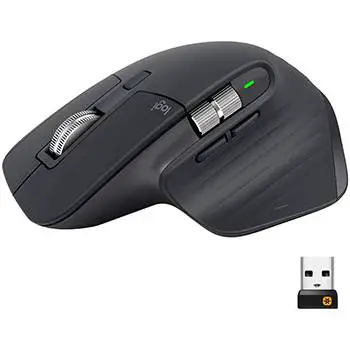 If you want the best ergonomic computer mouse, then the Logitech MX Master 3 should be the first one on your list. It’s available in two colors, graphite, and grey, and both are equally stunning.
If you want the best ergonomic computer mouse, then the Logitech MX Master 3 should be the first one on your list. It’s available in two colors, graphite, and grey, and both are equally stunning.
Key Features
- Equipped with five buttons and two scroll wheels
- Advanced 2.4 GHz wireless technology
- Five times faster and more precise than a regular mouse
If you’re looking for an ergonomic gaming mouse, we highly recommend this one. The 4,000 DPI sensor makes it an excellent choice for serious, professional gamers.
This ergonomic mouse has five customizable buttons and two scroll wheels. Thanks to the great placement of these buttons and wheels, you’ll achieve a lot without having to put pressure on your wrist.
Pros
- You can use it on up to three devices at the same time
- The design is large enough to suit any hand size comfortably
- It’s surprisingly fast and precise
- Works on any kind of surface
Cons
- It’s more expensive than some of the other options on this list, so be sure you’re ready to make such a big investment before buying
If you want to get things done fast and as precisely as possible, you should get the Logitech MX Master 3 ergonomic mouse. Although most people think of a vertical mouse when they want an ergonomic design, this one is living proof that horizontal designs can also be on top of the game.
2. Logitech ERGO Wireless Trackball Mouse
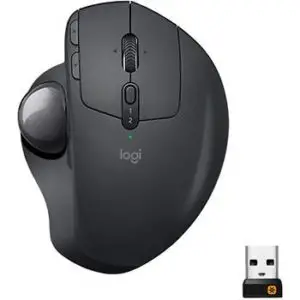 The Logitech Ergo trackball mouse is an excellent choice for everyone who loves a trackball design. It’s equipped with various customizable buttons to help you get work done much faster and easier, and it’s also comfortable for more casual use.
The Logitech Ergo trackball mouse is an excellent choice for everyone who loves a trackball design. It’s equipped with various customizable buttons to help you get work done much faster and easier, and it’s also comfortable for more casual use.
Key Features
- Minimal and maximal value: 512 to 2048 DPI
- You can pivot it 20 degrees
- Two traditional clickable buttons, a clickable wheel, navigation buttons, a switch, and a thumb button
One of the greatest things about this mouse is you can use it on up to three Windows or Mac computers. It also employs a specialized cross-computer control feature which allows you to do things simultaneously on two computers with Logitech flow.
Pros
- You can use it on up to three computers simultaneously
- Lasts up to 70 days on a single charge
- Tilt feature for a natural hand position that simulates a vertical mouse
Cons
- It’s too costly of an investment for some consumers
Is this the best ergonomic trackball mouse on the market? Although it’s hard to tell and everyone prefers different features, it’s safe to say that this Logitech product is highly praised by thousands of people and is a high-quality option.
3. Microsoft Sculpt Ergonomic Mouse
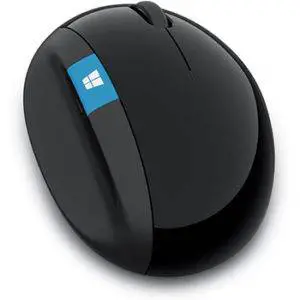 The Microsoft Sculpt mouse is the best ergonomic computer mouse for Windows users. Microsoft has made it super easy for you to integrate the device with your Windows technology by clicking a single button.
The Microsoft Sculpt mouse is the best ergonomic computer mouse for Windows users. Microsoft has made it super easy for you to integrate the device with your Windows technology by clicking a single button.
Key Features
- Microsoft button for easy access
- Advanced BlueTrack technology
- Unique spherical shape
The main goal of an ergonomic mouse is to make your hand feel comfortable and to prevent pain. This Microsoft design might be simpler than the rest we included in the list, but it still does its job.
Pros
- Easy to integrate with Windows systems, even for less tech-savvy users
- Place your hand at a 45-degree angle to imitate the natural posture
- Affordable price
Cons
- BlueTrack technology doesn’t work on glass or mirror surfaces
This is one of the top ergonomic mice for supporters of Windows operating systems because it is both comfortable and incredibly easy to set up and use. Your hand will feel comfortable, the price is affordable, and the design is sleek. If you love this mouse, check out some of the other great ergonomically designed Microsoft products we’ve reviewed here.
4. Kensington Expert Wireless Trackball Mouse
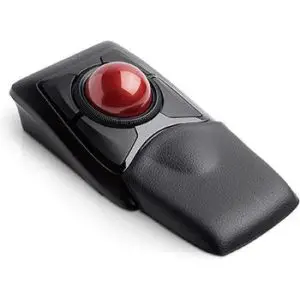 The Kensington Expert Wireless Trackball ergonomic wireless mouse features a trackball design with a surprisingly large and easy-to-move ball. The 55 mm red ball placed in the center also has a scroll ring around it for you to move the cursor up and down with ease.
The Kensington Expert Wireless Trackball ergonomic wireless mouse features a trackball design with a surprisingly large and easy-to-move ball. The 55 mm red ball placed in the center also has a scroll ring around it for you to move the cursor up and down with ease.
Key Features
- Large 55 mm scroll ball with a convenient scroll ring around it
- Auto-sleep feature
- Detachable wrist support
This ergonomic mouse has four customizable buttons that will make things very simple for you. If you’ve never used a trackball design before, you might need a little practice.
Pros
- It suitable for left and right-handed people
- Three-year warranty and lifetime technical support
- Works with Windows, macOS, and Chrome devices
- The detachable wrist-rest creates an even comfier seat for your hand
Cons
- Some reviewers noted the mouse is a bit noisy
If you love ergonomic trackball mice, then the Kensington Expert Wireless mouse should be high on your list. It’s not the most affordable purchase on our list, but it’s worth every single dollar you’ll pay.
5. Anker 2.4G Wireless Optical Vertical Mouse
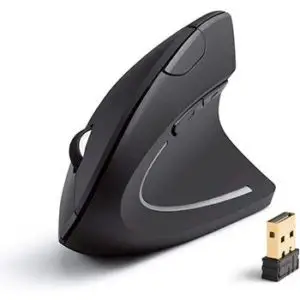 The Anker 2.4G Optical is another vertical mouse that made its way to our list. It looks different than all the others we listed, and it will take a little getting used to. However, once you’ve gotten comfortable with using its unique design, this particular mouse is an excellent choice.
The Anker 2.4G Optical is another vertical mouse that made its way to our list. It looks different than all the others we listed, and it will take a little getting used to. However, once you’ve gotten comfortable with using its unique design, this particular mouse is an excellent choice.
Key Features
- 800/1200/1600 DPI settings
- Power-saving mode
- Five buttons for easy use
It’s safe to say that this is the best ergonomic vertical mouse, as it is praised by thousands of users for its superior features. It works perfectly for most hand sizes and has five buttons and a sensitive DPI.
Pros
- Highly sensitive and precise
- Comes with an 18-month warranty
- Fits most hand sizes
Cons
- Its unconventional design takes time to get used to using
The Anker 2.4G Wireless Optical vertical mouse will be your new favorite mouse, especially if you already prefer this mouse type. It holds your wrist in a neutral position, removing pain and reducing the overall pressure and tension created when using a mouse for extended periods.
FAQs For Choosing An Ergonomic Mouse
Does an ergonomic mouse help?
Will an ergonomic computer mouse help your pain, discomfort, and overall hand and wrist health? Yes! Ergonomic mice are built specifically to support your arm, wrist, muscles, and tendons more than a standard mouse. It will relieve the stress and tension normally associated with using a standard mouse and prevent the surrounding tissues from putting pressure on delicate nerves.
How long does it take to get used to an ergonomic mouse?
You should wait for at least a week before giving up on your ergonomic mouse. Regardless of the type of ergonomic mouse you choose, you’re going to need to be patient and allow yourself to adjust to using it. After using it for a week or so, you’ll likely become even more comfortable using it than you ever were with using a standard mouse.
Conclusion
How can you decide which is the best ergonomic computer mouse? First of all, go over the different types of ergonomic mice, and choose which type works best for you. Next, check features such as customizable buttons, whether the mouse is wireless or wired, DPI, hand size the mouse is designed for, etc. Finally, take a look at the price and decide whether it fits your budget.
The best ergonomic mouse for you will likely be one that makes your hand feel comfortable, removes tension, strain, and pain, and prevents further injuries. Our overall favorite is the Logitech MX Master 3 Advanced Wireless Mouse because of its multiple features, numerous customizable buttons, high precision, and speed.
If you’re looking for a vertical mouse, don’t hesitate to try the Anker 2.4G Wireless Optical Vertical Mouse. Alternatively, if you have a trackball mouse in mind, the best trackball design according to our research is the Logitech ERGO Wireless Trackball Mouse.
- Your Complete Guide To The Best Ergonomic Kneeling Chairs - March 25, 2024
- 5 Best Ergonomic Wine Bottle Openers - March 4, 2024
- Handshoe Mouse Review - January 23, 2024


